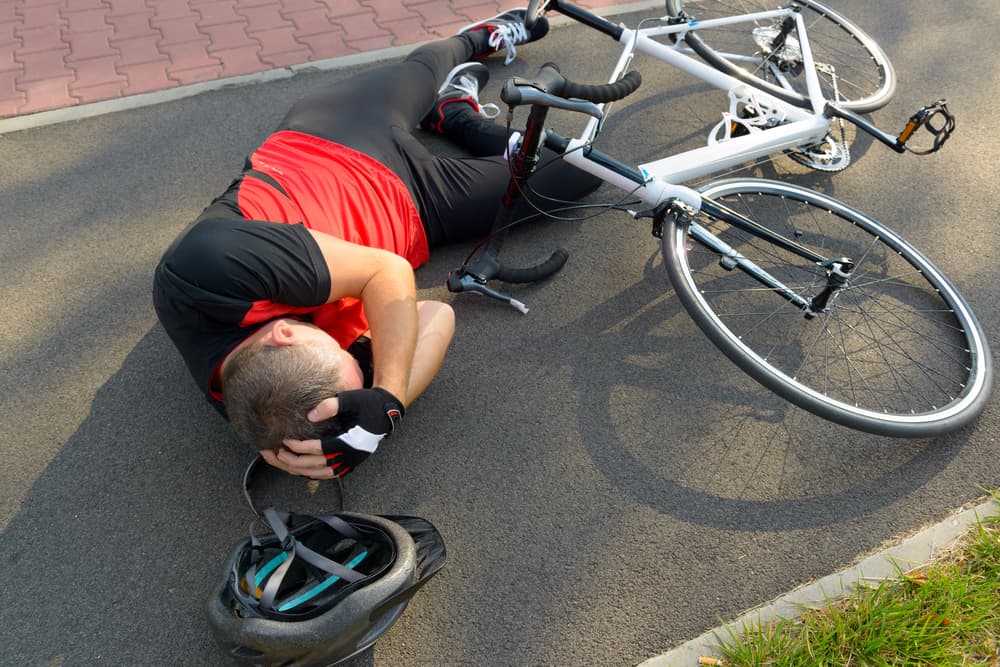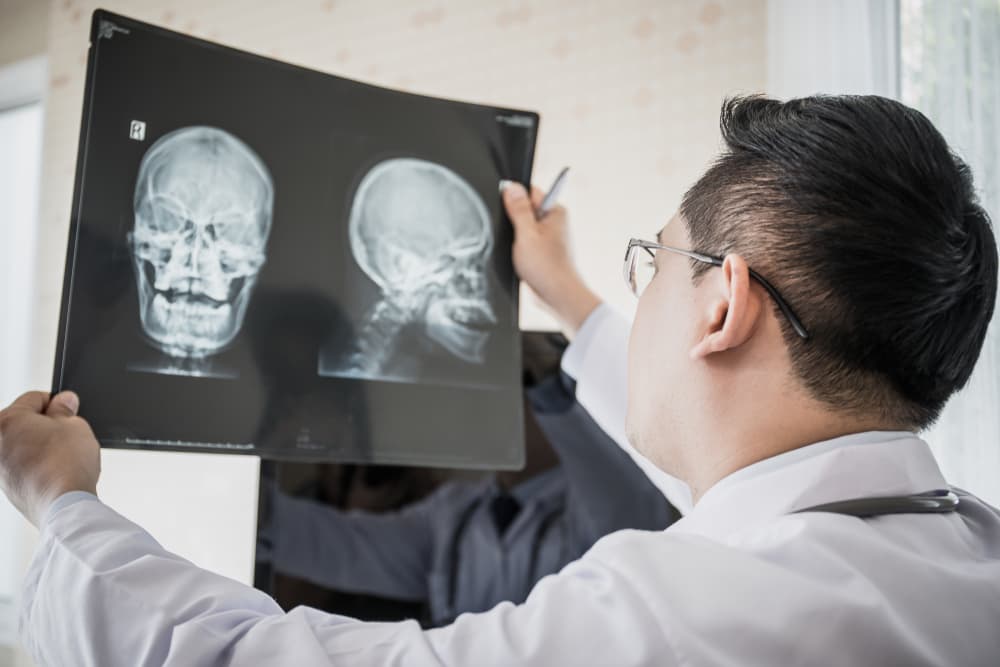A bicycle accident can be a life-altering event with the potential for permanent impairments, especially if you are a cyclist who suffered a head injury. While you may be entitled to compensation, your road to financial recovery can be treacherous and overwhelming. That is why you should always consider hiring a lawyer to assist you with your case.
But how can a bicycle accident attorney help after suffering a head injury in this type of collision? The best way to know is to seek a free consultation with a law firm near you.
Common Types of Head Injuries in Bicycle Accidents and How They Occur

Statistics show that one-third of non-fatal injuries suffered by bicyclists in traffic accidents are to the head. Let’s review some of the most common types of head injuries that result from cycling accidents and how they occur:
Traumatic Brain Injury (TBI)
A traumatic brain injury (TBI) occurs when an external mechanical force leads to brain dysfunction. TBIs range from mild (often considered as concussions) to severe, entailing prolonged periods of unconsciousness or amnesia after the injury.
How it occurs: Cyclists can suffer TBIs when they are thrown off their bicycles and hit their heads on the pavement, collide with a vehicle, or strike a stationary object.
Concussion
A concussion is a type of TBI that is often mistakenly considered mild, but its effects can be very serious. A concussion is caused by a blow to the head or a violent shaking of the head and body. Symptoms can include headaches, dizziness, confusion, and memory loss. They can appear immediately or may be delayed.
How it occurs: Concussions often result from the sudden acceleration-deceleration of the head, which can happen during a bicycle accident when a rider is knocked off their bike, and their head whips back and forth or strikes an object like the ground or a car.
Contusion
A contusion is essentially a bruise on the brain caused by a direct impact on the head. Due to the bleeding and swelling that a contusion can present, it might be a life-threatening condition demanding immediate medical attention.
How it occurs: Contusions typically occur directly under the impact site. For cyclists, this can happen when their head directly impacts the ground, a vehicle, or any other hard surface during a crash.
Skull Fracture

The impact from a bicycle accident can break or fracture the skull. Skull fractures can be linear, depressed, diastatic, or basilar. The gravity of a skull fracture depends on the force of impact and the type of fracture; some may require surgical intervention if there is a risk of brain damage.
How it occurs: A skull fracture can occur from a high-impact collision that causes the skull bones to crack or break. This may occur when a cyclist falls and hits their head on a hard surface without any protection.
Diffuse Axonal Injury (DAI)
Diffuse Axonal Injury (DAI) involves widespread damage to the brain’s white matter, the part of the brain that coordinates communication between different brain regions. This type of injury can disrupt normal brain function and may lead to permanent brain damage or death.
How it occurs: DAIs can happen in bike accidents when the head is violently jerked or rotated, disrupting the delicate axonal fibers in the brain.
Hematoma
In the context of a head injury, a hematoma is a pooling of blood outside the blood vessels. This can occur within the skull around the brain and can be epidural, subdural, intraparenchymal, or intraventricular. Hematomas can place immense pressure on the brain, leading to loss of consciousness or permanent brain damage. Immediate neurosurgical intervention may be required.
How it occurs: In bicycle accidents, hematoma may occur in or around the brain following a violent blow to the head.
Maxillofacial Trauma
Maxillofacial trauma refers to injuries to the face and jaw. Multiple fractures, dental injuries, and soft tissue injuries are common in these accidents and can require surgical reconstruction or lead to long-term disfigurement.
How it occurs: Cyclists often experience these types of injuries when their faces strike a part of their bicycle, the ground, or a vehicle. Impacts can result in broken facial bones, dental injuries, or lacerations.
Factors That Contribute to Head Injuries in Bicycle Accidents

Injury to the head is a common consequence of bicycle accidents. Statistically speaking, brain injuries account for the majority of the head injuries treated in emergency rooms after bicycle accidents. While head injuries are a common occurrence in bicycle accidents, certain factors can make the victim’s head trauma worse. Some of these factors include:
- Whether the bicyclist is wearing a helmet. The role of helmets in protecting bicyclists is widely recognized among safety experts. A major factor contributing to the severity of a head injury in an accident is whether the rider is wearing a helmet. Helmets are designed to absorb impact and provide cushioning to the skull, and their use – or lack thereof – can be a decisive element in the outcome of a collision. In the past, studies have shown that helmet use can decrease the risk of head and brain injury among cyclists by 65 percent to 88 percent.
- The speed of the vehicles involved. The speed at which a bicycle and any involved vehicle travel during an accident also plays a critical role. High speeds can escalate the force of impact, increasing the likelihood and severity of a head injury. Crashes that occur at lower speeds may still result in harm, but the intensity and potential for severe head trauma are magnified with increased velocity.
- The age and health condition of the bicyclist. A bicyclist’s age and overall health condition are personal factors that can influence the risk and consequences of head injuries. Younger individuals may have more resilience to injury, while older adults might be more prone to serious consequences due to potentially brittle bones and slower recovery processes.
- Whether the bicyclist had any pre-existing head injuries. Bicyclists with a history of head injuries may face increased jeopardy. A prior injury can make the brain more susceptible to subsequent trauma, and additional impacts can exacerbate the severity of new head injuries.
In many bicycle accidents, the cyclist does not need to hit their head to suffer injuries to the head on the ground or other objects. Some types of head injuries may occur when the cyclist’s head violently shakes due to the force of impact.
The Challenges of Living with a Head Injury After a Bicycle Accident
A head injury resulting from a bicycle accident can have far-reaching implications that extend beyond the initial impact. Coping with the aftermath often means facing various challenges that can profoundly affect one’s life. Some of these challenges include:
Memory Loss
One of the most common and distressing outcomes of a head injury is memory loss. Memory issues can range from slight forgetfulness to significant gaps in one’s recollection of past events or difficulty forming new memories. This can disrupt day-to-day activities and pose problems in personal and professional life.
How long will it last? The duration of memory loss varies greatly. In mild cases, memory may return within weeks, while more severe injuries can result in long-term or permanent memory impairment.
Difficulty with Focus and Concentration
After sustaining a head injury, many find that their ability to concentrate is compromised. This difficulty with the ability to focus can impede work performance, studying, and even the simple act of reading a book or watching a movie. These changes can amount to a frustrating decline in quality of life and independence.
How long will it last? Cognitive rehabilitation can improve focus and concentration over time, but some may experience lingering effects for months or even years post-injury.
Physical Changes
Physical changes might include chronic headaches, dizziness, fatigue, and sleep pattern disruptions. These symptoms can be persistent and debilitating, requiring individuals to adapt their activities and lifestyles entirely.
How long will it last? These physical symptoms may subside as the brain heals, but some people may deal with these issues for an extended period, potentially becoming chronic conditions.
Personality and Behavioral Changes
It is not uncommon for survivors of head injuries to experience alterations in their personality and behavior. They might grapple with impulsivity, irritability, or apathy, which can strain relationships with friends and family. Understanding and patience from loved ones become essential during this adjustment period.
How long will it last? Personality and behavioral changes can be temporary or permanent depending on the injury’s severity and affected brain areas. Some individuals may notice improvements, while others may require long-term management and ongoing support.
Cognitive Changes
Cognitive changes touch on everything from information processing to problem-solving ability. Adapting to these changes often requires professional help, such as cognitive therapy or rehabilitation programs.
How long will it last? Cognitive recovery is unpredictable and can either progress slowly over the years or remain persistently altered. Continued therapy and support often have positive impacts on cognitive function.
Depression and Anxiety
The psychological impact of a head injury should not be underestimated. Victims often face depression and anxiety as they come to terms with the changes in their capabilities and independence. Mental health support, including therapy and medication, can be necessary components of recovery.
How long will it last? The onset of depression and anxiety may be immediate or delayed and can persist for a significant period. It is imperative to seek professional help for these conditions, which can be managed with appropriate treatment and support.
Why You Need a Bicycle Accident Lawyer’s Help if You Suffered a Head Injury
In the wake of a head injury, trying to represent yourself legally can be overwhelming and disadvantageous. Working with a bicycle accident attorney is beneficial in such cases because they can help you with the following and more:
- Build a strong case by gathering evidence. Collection of evidence is vital to prove the extent of your injuries and the circumstances of the accident. A lawyer has the experience to compile relevant documentation, including medical records and witness statements, that can strengthen your case.
- Connect the head Injury to the accident. One of the complexities of a head injury case is demonstrating that the injury is a direct consequence of the accident. To establish this connection, a lawyer will understand how to effectively present medical data and expert testimony.
- Prove the other party’s liability for the head injury. The success of your compensation claim depends on your ability to prove that the other party is liable. Your bicycle accident attorney will scrutinize the details of your case to establish the other party’s negligence, which is a term used to describe someone’s deviation from a reasonable standard of care.
- Help you deal with the insurance company. Insurance companies are often more concerned with minimizing payouts to claimants than providing fair compensation. A lawyer can use their experience to communicate and negotiate with insurers, ensuring your rights are protected.
- Navigate the insurance claims process on your behalf. The insurance claims process can be daunting due to its myriad of procedures and legal nuances. An experienced lawyer can help you navigate these complexities, allowing you to focus on your health and recovery.
- Negotiate a fair settlement offer. A lawyer can accurately assess the worth of your claim, considering current and future expenses, costs, and losses. They will use their experience to negotiate a settlement that reflects the full impact of the head injury on your life.
- Take your case to court if necessary. Should negotiations stall or an insurance company refuse a fair settlement, your lawyer will be prepared to take your claim to court to fight for the compensation you need.
After a head injury from a bicycle accident, legal intricacies should be the least of your concerns. You need to dedicate your time and energy to healing and getting back on your feet without worrying about your claim’s legal aspects. That is why a bicycle accident lawyer’s representation can make all the difference in such trying times.
Never wait to schedule your free consultation with a trusted personal injury law firm in Henderson today.
